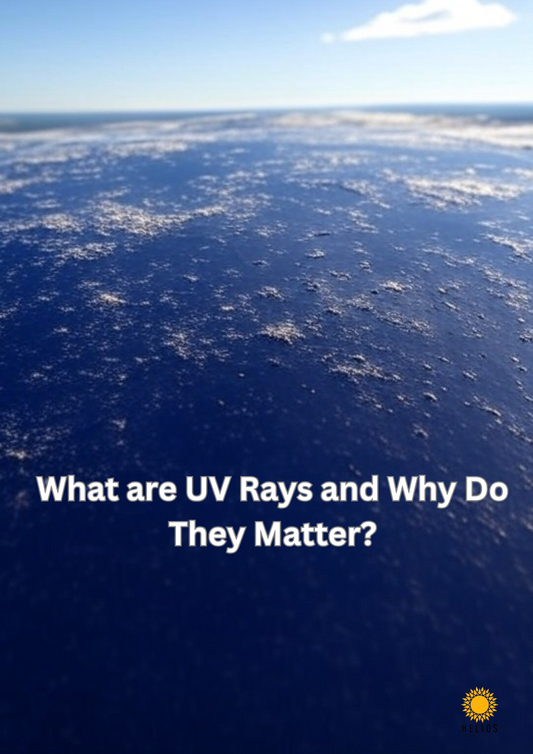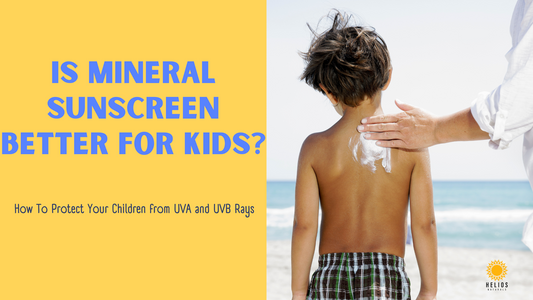
What Are UVA and UVB Rays and Why Do They Matter?
Share
UV is short for ultraviolet, UV rays are radiation that come from the sun. UV rays are a bit of a double edged sword while too much of them can cause skin and eye damage, they’re essential for vitamin D production.
UVA stands for ultraviolet A, a type of long-wave radiation and UVB rays are short-wave radiation. Both of these types of rays have certain drawbacks but they’re necessary for life.
These UV rays matter because they help prevent seasonal depression disorder (SAD), improve circadian rhythm, and have large impacts on our skin health.
Too much of them can cause damage but not enough of them can lead to negative health effects as well. It’s important to build a healthy relationship with the sun to maximize the benefits and avoid the detrimental effects.
What Are UVA Rays?
As mentioned UVA rays stand for ultraviolet A rays, they’re the long wave radiation that accounts for up to 95% of UV rays that reach the earth’s surface.
UVA rays penetrate deep into the skin and can cause premature aging, wrinkles, and even skin cancer by damaging the DNA of skin cells. There are 500x more UVA rays than UVB rays in sunlight.
According to a NIH study, UVA rays induce nitric oxide, which may improve blood pressure and improve cardiovascular health.
What Are UVB Rays?
UVB is short for Ultraviolet B, short-wave radiation that affects the top layer of the skin. UVB rays are responsible for sunburn and can even damage skin cells’ DNA.
UVB rays tend to be the most intense during midday in the summer months. High altitude areas or being near reflective surfaces like water can magnify their impact as well.
Although UVB rays can cause sunburn, they’re instrumental to get enough vitamin D. Sunlight is a great way to get vitamin D without swallowing a supplement.
How Do UVA and UVB Rays Differ?
The major difference between UVA and UVB rays is their wavelength, UVA rays are longer (320--400 nm) while UVB rays are shorter (280--320).
Since UVA rays are longer they’re able to penetrate deeper into the skin layer. UVB rays primarily only affect the stop of the skin layer or epidermis. UVB rays are responsible for sunburn. Both rays can be harmful in different ways when overexposed to them. UVB rays are more harmful in the short-term because they cause sunburn. UVA rays are what can cause skin cancer like melanoma.
How Can You Protect Against UVA and UVB Rays?
The best way to protect against UVA and UVB rays is from UV-protective clothing, the second best way is using a broad-spectrum sunscreen.
Physical barriers like clothing and hats help shield you from both types of UV rays. These can be especially helpful if you don’t want to reapply sunscreen often.
Look for SPF30 or higher for longer UVB and UVA protection, ingredients like non-nano zinc oxide or avobenzone for UVA. The important thing is the sunscreen must have broad-spectrum protection to be effective. Regardless if you’re wearing mineral or chemical sunscreen you’ll have sun protection.
If you decide to use sunscreen it’s important to reapply every 2-3 hours. If you’re using a chemical sunscreen you must apply it in the shade or indoors and let it absorb for 15 minutes for it to be effective. Mineral sunscreen works immediately once applied to the skin but leaves a sometimes undesirable white cast.
Why Is UV Protection Important?

UV protection is important because overexposure to UVA and UVB can lead to premature aging, skin cancer, cornea damage, and other health risks.
The following factors can increase UV exposure:
- High altitude areas
- Reflective surfaces like snow and bodies of water
- Thinner ozone layer
- Time of day, 12pm-2pm is when UV is typically higher
To protect yourself against UV rays, it’s best to use sunscreen with broad spectrum protection and clothing to shield you from the negative effects.
What Are The Benefits of UV Rays?

While we’ve discussed at length the risks of UV rays but UVB rays in particular are critical in vitamin D production, circadian rhythm, and
Vitamin D is important for the following health benefits:
- Bone health
- Muscle strength
- Heart disease
- Type 2 diabetes
- Immune system
- Cognitive decline
- Seasonal Depression (SAD)
Overall, getting adequate vitamin D is critical to live a healthy life and the best way to get it is through UV rays.
Are There Myths About UVA and UVB Rays?
Does a cloudy day block UV rays?
No, up to 80% of UV rays can penetrate clouds, making protection necessary even on overcast days. You are more likely to burn because you can’t feel the UV damage on your skin compared to a sunny day.
Does a tan protect your skin from UV damage?
According to a 2012 study from Dermato Endocrinology, a tan increases melanin in your skin so it provides some protection from UV damage but not enough compared to broad spectrum SPF products.
Do darker skin tones need sun protection?
Yes, while melanin provides some natural protection, everyone is susceptible to UV damage and skin cancer.
Why is Understanding UVA and UVB Rays Essential?
Understanding UVA and UVB rays are essential to reap the benefits but limiting the harmful effects of them.
Knowing the effects of UVA and UVB rays helps you make informed decisions to protect your skin, eyes, and overall health. With the right precautions, you can enjoy the outdoors while minimizing risks .We don’t want to spend too much time outside and risk skin damage but by the same coin, we need sunlight for vitamin D production and help regulate our circadian rhythm.
If you want to protect yourself from UV rays, give Helios a try. It’s a natural mineral sunscreen that’s able to reflect UV rays from your skin and works upon application.



